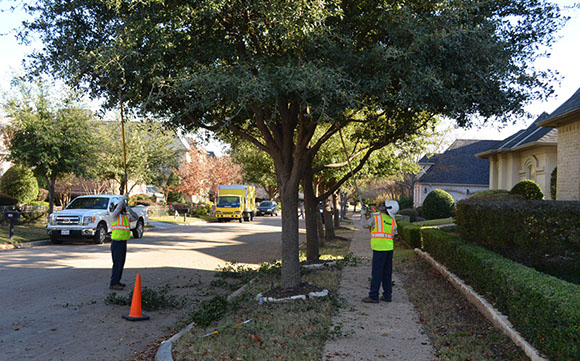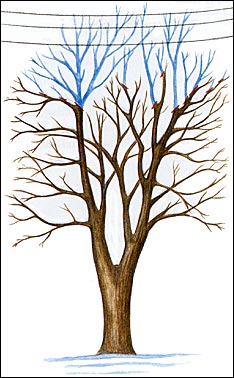Tree Pruning & Trimming
TREE PRUNING & TRIMMING METHODS
|
|
|---|---|
 |
Crown cleaning includes the removal of dead, dying, diseased and broken branches. Most arborists have been trained from the first time they picked up a saw to remove these branches without hesitation. An example of a crown cleaning specification might be, “crown clean to remove dead, dying and broken branches 1" or 2” diameter or more significant”. |
 |
Crown thinning is the selective removal of branches to increase light penetration and air movement through the tree's crown. Crown thinning opens up the foliage of a tree, reduces weight on heavy limbs and helps retain the tree’s natural shape. In most cases, no more than one-third of the live foliage should be removed when thinning a tree. When crown thinning is necessary, the arborists might write, “crown thinning to remove excess interior branches 1' diameter or larger”. |
 |
Crown raising consists of pruning or removing lower branches or limbs to provide vertical clearance. Distances from objects to be cleared or heights above ground level let the pruning arborist know how much of the lower canopy or how many lower branches need to be pruned from the tree. Crown raising might be done on the entire bottom of the crown or only on one portion. A crown raising specification could be as follows: “crown raise entire lower canopy to 6 – 15’ above ground level”. |
 |
Crown reduction clears tree branches from objects such as buildings, signs or lights. Crown reduction pruning is also utilized to reduce the tree's canopy to decrease the canopy's height and/or spread. Branch tips are cut back to lateral branches that can take over as the terminal growth point. This is different from tree topping, which is simply cutting back branches at random points or preassigned distances in the tree with little regard to the remaining branch or the presence or location of lateral branches. Crown reduction pruning should state what object the branches are being cleared from and how far they should be pruned back, such as, “crown reduce to establish 3 – 5’ clearance from house”. |
 |
Crown restoration is usually the necessary type of pruning for trees that have sustained damage from storms or have been vandalized. Branches may be cut back to smaller than normal-sized lateral branches in the hope that the tree will retain, or eventually regain, its natural form and appearance. A crown restoration specification can vary quite a bit depending on the pruned tree species and the type of damage that has occurred. An example might be, “crown restore by removing weak or broken branches back to lateral branches that are at least 1/3 the diameter of the parent limb”. |
 |
Espalier pruning is rarely seen on this side of the Atlantic Ocean but was common in Europe, where small courtyards could accommodate trees if they were pruned to stay tight against a wall. Espalier pruning requires a lot of time and effort, but the resulting plant is almost always attractive and eye-catching. I’ve never had to write specifications for espalier pruning. Still, if I did, it might be like this: “Prune all non-horizontal growth to maintain current, horizontal branching habit. The most common espalier pruning is Cedar Hedge Trimming. |
 |
Vista pruning is used to prune or remove branches to improve the view of scenery or an object from a predetermined point. Vista pruning involves removing whole branches or requires thinning, or over-thinning, a selected portion of the tree canopy. Pruning specifications for Vista pruning will depend mainly on what view is trying to be obtained. Still, they could be as simple as, “when looking from the patio, remove the lowest branch on the left side of the tree back to the main trunk and remove the three lowest branches on the right side of the tree back to the main trunk to improve the view of the lake”. |
|
To request a Tree Pruning & Trimming estimate, fill out the contact form on our contact us page to start the estimate process. We will schedule a site visit to assess the work. The estimate will be sent by email after a site visit has been done. |
|

